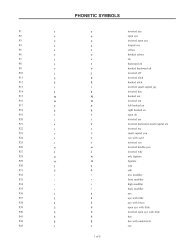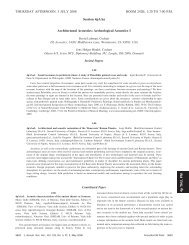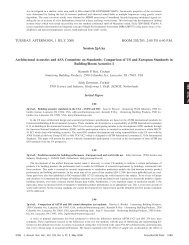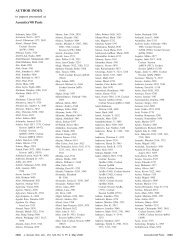Tuesday afternoon, 11 November - The Acoustical Society of America
Tuesday afternoon, 11 November - The Acoustical Society of America
Tuesday afternoon, 11 November - The Acoustical Society of America
You also want an ePaper? Increase the reach of your titles
YUMPU automatically turns print PDFs into web optimized ePapers that Google loves.
criteria is normal mode acoustic propagation with “slow enough” perturbations<br />
such that the modes adjust adiabatically to the perturbations, and the<br />
mode eigenvalues are “far” from cut<strong>of</strong>f. We examine the effects <strong>of</strong> the nonlinear<br />
components <strong>of</strong> the model and the higher order components <strong>of</strong> the<br />
model resolution on the reconstruction <strong>of</strong> the model estimate for a simple<br />
ocean acoustic propagation problem. Work supported by ONR.<br />
2:30—2:45 Break<br />
2:45<br />
2pUW5. Open ocean seamount geoacoustic inversion. Kevin D. Heaney<br />
OASIS Inc., Fairfax Station, VA 22039<br />
During the BASSEX-2004 Basin Acoustic Seamount Scattering<br />
Experiment, sound from three sources 250 Hz LFM, 100 Hz bandwidth<br />
and 75 Hz, m-seq, 50 Hz bandwidth was transmitted in a range <strong>of</strong><br />
200–250 km to a moving towed array receiver 200 m aperture, cut for 250<br />
Hz in the vicinity <strong>of</strong> two seamounts in the central North Pacific. <strong>The</strong> seamounts<br />
rise from a depth <strong>of</strong> 6000 m to approximately 1000 m below the sea<br />
surface. A simple sediment model s<strong>of</strong>t surficial unconsolidated sediment<br />
overlying a hard basement is used to try and model the energetics <strong>of</strong> the<br />
receptions. Two sets <strong>of</strong> receptions are used to perform this geoacoustic<br />
inversion. <strong>The</strong> first is a received energy versus range equivalent to TL versus<br />
range in the shadow behind the seamount. <strong>The</strong> depth <strong>of</strong> the received<br />
level minimum behind the seamount is sensitive to the sediment cover <strong>of</strong> the<br />
seamount. This approach is limited by the available signal-to-noise ratio at<br />
the receiver. <strong>The</strong> second approach is to use data taken when the receiver is<br />
just above the seamount. For this geometry, the beamformer is capable <strong>of</strong><br />
resolving direct propagating paths and paths that bounce <strong>of</strong>f the seamount<br />
up to the array from below.<br />
3:00<br />
2pUW6. Geoacoustic inversion over a basalt seafloor. Kevin D. Heaney<br />
and Michael Vera Univ. <strong>of</strong> Southern Missisippi, <strong>11</strong>8 College Dr., Hattiesburg,<br />
MS 39406<br />
Geoacoustic inversion from data just <strong>of</strong>f a volcanic island Kauai poses<br />
significant challenges. One <strong>of</strong> the significant challenges is to separate the<br />
effects <strong>of</strong> seafloor roughness and shear wave conversion in the basement.<br />
Lava flow fields are known to have significant roughness on several scales<br />
relevant to low-frequency acoustic propagation 75 Hz. Basalt is known to<br />
have a very high-compressional speed <strong>of</strong> 3000 m/s and a variable shear<br />
speed ranging from 500 to 2000 m/s. <strong>The</strong> combination <strong>of</strong> shear and roughness<br />
can lead to significant ambiguity while performing a geoacoustic inversion<br />
because both mechanisms can lead to attenuation <strong>of</strong> the coherent field.<br />
During the BASSEX 2004 experiment up to 20 transmissions from the fixed<br />
NPAL source 75 Hz, m-seq with a 50-Hz bandwidth were received on a<br />
towed horizontal line array at many orientations and ranges from the source.<br />
In this paper we look at several short-range transmissions and attempt to sort<br />
out the scattering effects <strong>of</strong> roughness with the attenuation effects <strong>of</strong> shear<br />
wave conversion in the sediment. <strong>The</strong> two mechanisms will be sorted out<br />
using simultaneous narrowband transmission loss and broadband<br />
inversions.<br />
3:15<br />
2pUW7. Inverting for the properties <strong>of</strong> an elastic seafloor using<br />
complex-density equivalent fluids. Michael Vera Univ. <strong>of</strong> Southern Mississippi,<br />
<strong>11</strong>8 College Dr., #5046, Hattiesburg, MS 39406 and Kevin Heaney<br />
OASIS Inc., Fairfax Station, VA 22039<br />
Receptions were recorded from a bottom-mounted broadband source<br />
with a center frequency <strong>of</strong> 75 Hz located near Kauai as part <strong>of</strong> the basin<br />
acoustic seamount scattering experiment BASSEX. Travel times for arriv-<br />
als from this source have been modeled at basin-scale ranges using<br />
complex-density equivalent fluids for the elastic seafloor material. <strong>The</strong> collection<br />
<strong>of</strong> acoustic data at shorter ranges as part <strong>of</strong> BASSEX allows for a<br />
more detailed examination <strong>of</strong> the accuracy attainable by an equivalent-fluid<br />
representation <strong>of</strong> the seafloor. <strong>The</strong> use <strong>of</strong> equivalent fluids is intended to depict<br />
the conversion <strong>of</strong> acoustic energy into shear waves. <strong>The</strong> performance<br />
and stability <strong>of</strong> propagation models can be substantially improved if equivalent<br />
fluids can be used to accurately characterize bottom interaction. Simulations<br />
have been performed in order to search for the equivalent fluid that<br />
best explains received data at a range <strong>of</strong> a few kilometers. <strong>The</strong> reflection<br />
coefficient <strong>of</strong> this equivalent fluid can then be matched to parameters <strong>of</strong> an<br />
elastic solid density, sound speed, and shear speed for the relevant grazing<br />
angles. <strong>The</strong> ability <strong>of</strong> these models to reproduce features <strong>of</strong> the data will<br />
serve to indicate the importance <strong>of</strong> elastic effects in the experimental results.<br />
Work supported by ONR.<br />
3:30<br />
2pUW8. Time domain integration to improve geoacoustic parameter<br />
estimation. Donald DelBalzo Planning Systems, 40201 Hwy 190 East,<br />
Slidell, LA 70461, ddelbalzo@plansys.com, James Leclere, and George<br />
Ioup Univ. <strong>of</strong> New Orleans, New Orleans, LA 70148<br />
Shallow-water acoustic predictions are affected by uncertainty in sediment<br />
property characteristics. Inverse methods using controlled active<br />
source signals have been developed to estimate seabed properties. However,<br />
some applications prefer a more covert approach. Our work is focused exclusively<br />
on passive inversion techniques using signals from surface ships <strong>of</strong><br />
opportunity. This study addresses the accuracy <strong>of</strong> low-frequency 100 Hz<br />
matched-field correlations and subsequent geoacoustic estimates using signals<br />
from moving surface ships with unknown source levels at unknown<br />
ranges. A time-staggered technique is employed to reduce ambiguities in<br />
thick-sediment descriptions, with ever increasing confidence as time<br />
evolves. Matched-field techniques are applied in a simulated shallow-water<br />
environment with a single vertical line array and high signal-to-noise ratios.<br />
<strong>The</strong> simulations indicate significant potential for accurate estimates <strong>of</strong> thicksediment<br />
characterizations <strong>of</strong> grain size and layer thickness out to ranges <strong>of</strong><br />
tens <strong>of</strong> water depths in shallow water, despite moderate mismatch conditions<br />
in the environmental model. Work sponsored by SPAWAR.<br />
3:45<br />
2pUW9. Attenuation inversions using broadband acoustic sources. Gopu<br />
R. Potty Dept. <strong>of</strong> Ocean Eng., Univ. <strong>of</strong> Rhode Island, Narragansett, RI<br />
02882, Preston Wilson <strong>The</strong> Univ. <strong>of</strong> Texas at Austin, Austin, TX<br />
78712-0292, James F. Lynch, Arthur Newhall Woods Hole Oceanograph.<br />
Inst., Woods Hole, MA 02543, and James H. Miller Univ. <strong>of</strong> Rhode Island,<br />
Narragansett, RI 02882<br />
Low-frequency attenuation data are widely scattered. <strong>The</strong> spread most<br />
likely reflects differences in sediment type, degree <strong>of</strong> consolidation, layering,<br />
as well as other causes <strong>of</strong> effective attenuation encountered during lowfrequency<br />
field measurements. Moreover, attenuation varies with depth, and<br />
longer wavelengths, i.e., low frequencies, encounter deeper sediments with<br />
different properties. <strong>The</strong> assumption that the attenuation in the sediment is<br />
constant with depth <strong>of</strong>ten results in interpretations which give sediment attenuations<br />
with a frequency dependence different when depth variations are<br />
included in the sediment description. Low-frequency attenuation inversions<br />
using broadband acoustic data from different field experiments will be presented<br />
and compared. Compressional wave attenuation will be estimated using<br />
modal amplitude ratios. Variation <strong>of</strong> modal attenuation coefficients with<br />
frequency and depth will be discussed. Work supported by the Office <strong>of</strong><br />
Naval Research.<br />
2502 J. Acoust. Soc. Am., Vol. 124, No. 4, Pt. 2, October 2008 156th Meeting: <strong>Acoustical</strong> <strong>Society</strong> <strong>of</strong> <strong>America</strong><br />
2502







